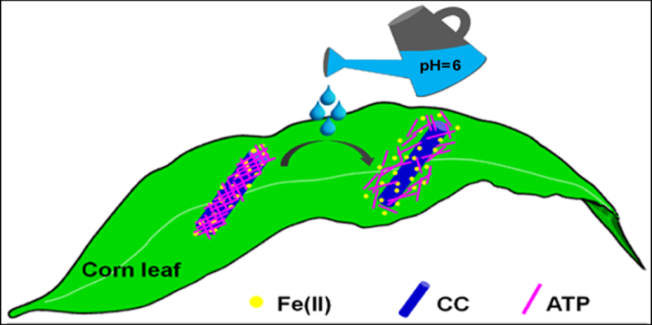
Iron is a vital microelement for the growth of crops, especially for normal functioning of multiple metabolic and physiological processes. Iron deficiency is a worldwide problem in modern agriculture, which causes leaf chlorosis and severe decline in crop yield.
Traditional ferrous foliar fertilizer (FFF) such as ferrous sulfate is widely applied due to its quick-acting and environmental-friendly properties. However, to be easily oxidized from Fe(II) to Fe(III) which is invalid for plants and the low adhesion capacity on leaf surface of crops made FFF with a low utilization efficiency and short active duration. Hence, a new FFF with an excellent oxidation resistance and a high adhesion capacity needs to be developed.
Given this, a study team led by Professor WU Zhengyan in Institute of Technical Biology and Agriculture Engineering, Hefei Institutes of Physical Science of the Chinese Academy of Sciences developed a pH-controlled-release ferrous foliar fertilizer (PCRFFF) derived from ferrous sulfate, microcrystalline cellulose and nanoclay.
The fabrication process and mechanism of PCRFFF is investigated. Fe(II) can be effectively immobilized by carboxylate groups of carboxyl cellulose via chelation to form CC-Fe(II).
Meanwhile, nanoclay can uniformly coat the surface of CC-Fe(II) via hydrogen bonds between -OH of nanoclay and -COOH of CC-Fe(II). The chelation and hydrogen bonds are sensitive to pH of the medium, therefore the release of Fe(II) from PCRFFF can be modulated to meet the demands of plants in different growing periods.
In addition, PCRFFF shows a higher adhesion capacity on corn leaf surface compared with traditional ferrous foliar fertilizer because of the nanoscale effect of nanoclay, which is beneficial both to controlling the loss of ferrous foliar fertilizer and ultimately increasing the utilization efficiency of Fe(II).
This work may provide not only a promising approach to achieve a long-lasting supply of effective Fe(II) for crops, but also a potential utilization technology for crop stalks due to microcrystalline cellulose is largely generated from crop stalks.
The paper entitled Fabrication of pH-controlled-release ferrous foliar fertilizer with high adhesion capacity based on nano-biomaterial has been published in ACS Sustainable Chemistry & Engineering.
This research was supported by National Natural Science Foundation of China and Chinese Academy of Sciences.

This schematic diagram is showing the fabrication process and mechanism of CFFF. ( Image by WANG Min)

This schematic diagram is showing the release process of Fe(II) from PCRFFF on corn leaf surface.( Image by WANG Min)

86-10-68597521 (day)
86-10-68597289 (night)

86-10-68511095 (day)
86-10-68512458 (night)

cas_en@cas.cn

52 Sanlihe Rd., Xicheng District,
Beijing, China (100864)

